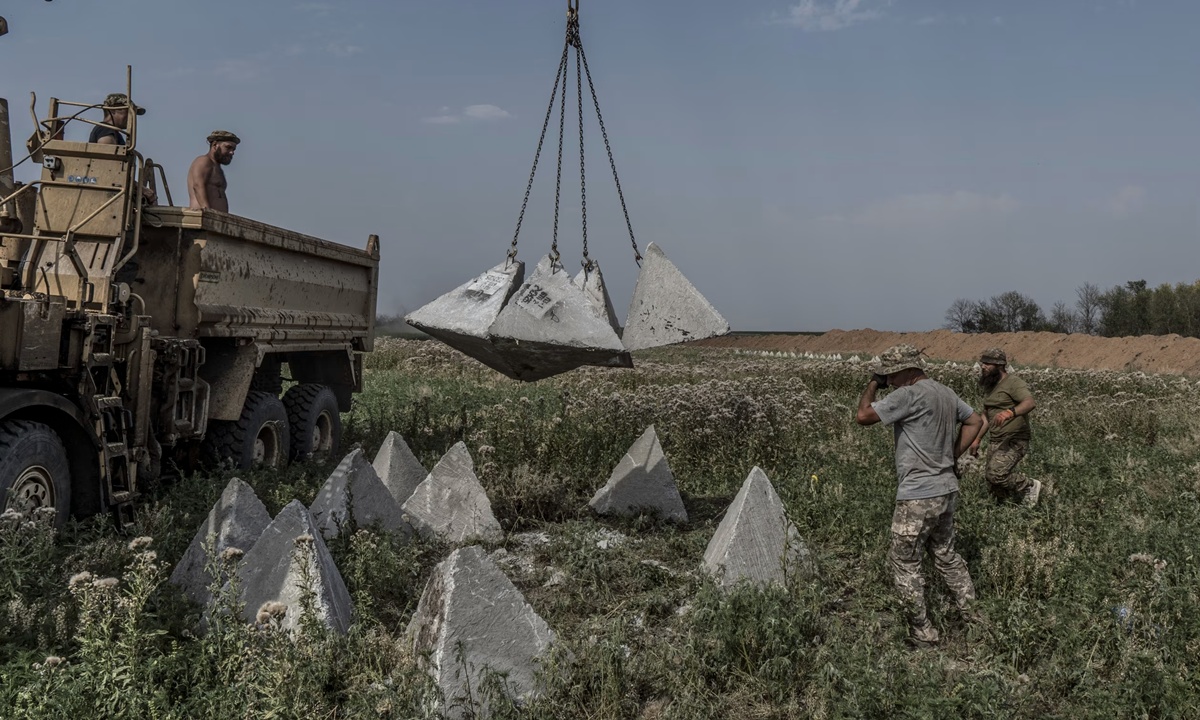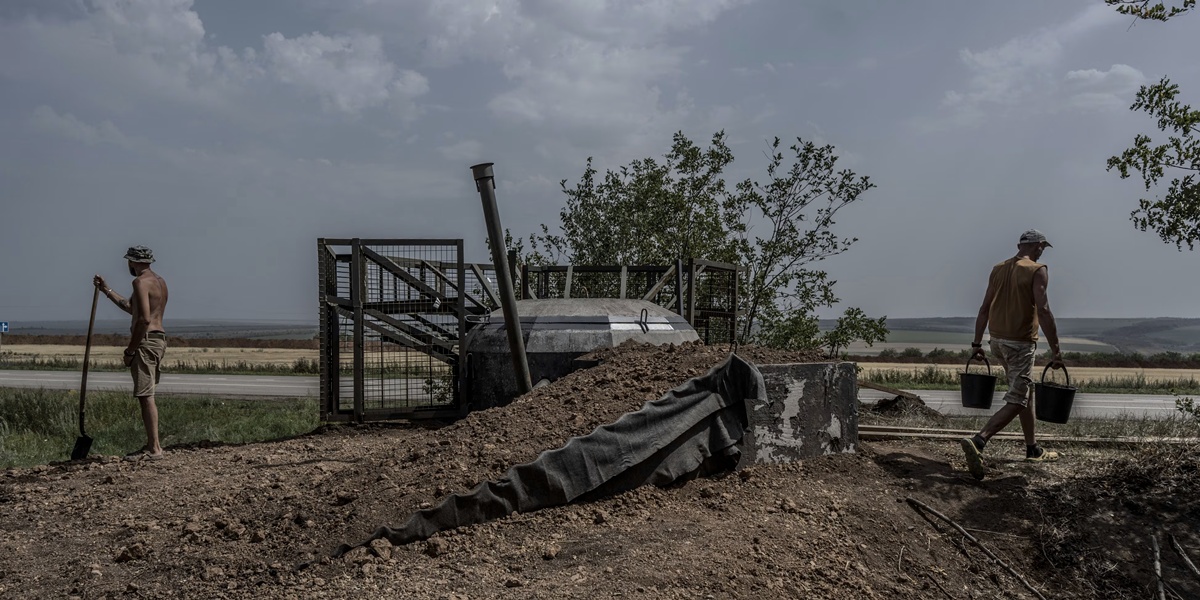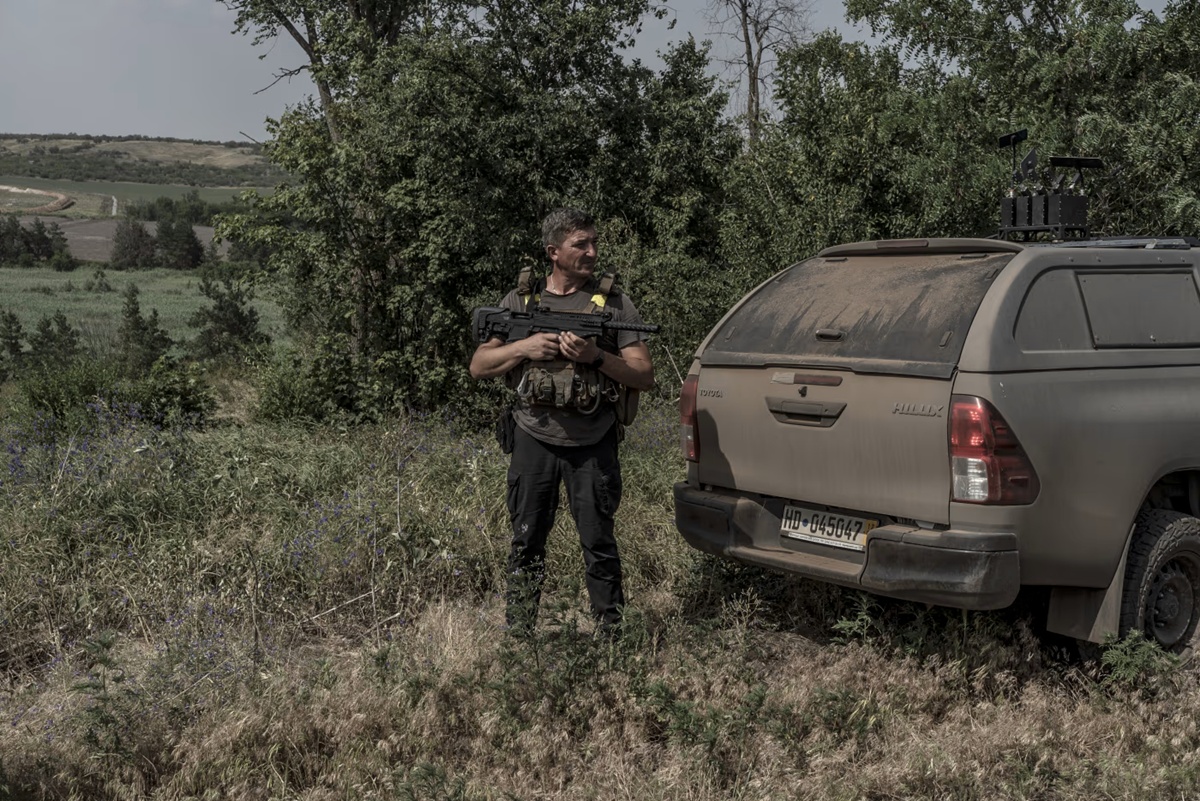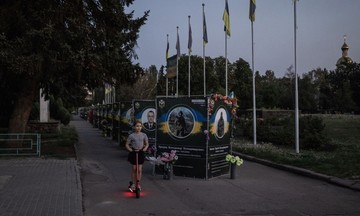An anti-tank ditch and barbed wire fence cut across sunflower fields stretching to the horizon in eastern Ukraine. This is the defensive line Kyiv hopes to build quickly and extensively enough to stop Russia's summer offensive. But the line's chances of success are dwindling.
Kyiv is pushing ahead with its most ambitious fortification effort yet, erecting dragon's teeth barriers and digging trenches to impede the enemy. Ukrainian drone pilots are also stationed in a vast network of underground bunkers to counter Russian UAVs.
 |
"Dragon's teeth" obstacles deployed against Russian tanks. Photo: WSJ |
"Dragon's teeth" obstacles deployed against Russian tanks. Photo: WSJ
"The side that digs deeper will survive," declared Colonel Oleh Rezunenko, the engineering officer in charge of constructing a nearly 322 km section of this massive defensive line.
Now in its second year, Ukraine's defense expansion program is facing a series of problems, from construction delays to the arrest of officials involved in the project on corruption charges. It now faces the risk of being breached by the enemy if the construction pace isn't accelerated.
Colonel Rezunenko's section of the line, with kilometers of dragon's teeth – pyramid-shaped concrete obstacles placed close together to stop tanks – starts from the Kharkov region in the north and extends down to Zaporizhzhia in the south.
"Our main task is to dig trenches as quickly and deeply as possible," he said.
The challenge is how to hold back a Russian army reinforced with thousands of new recruits. Undermanned Ukrainian units are struggling to defend against fierce attacks as Russia changes tactics daily and slowly gains ground.
Over the past 18 months, Russian forces have exploited weak points in Ukraine's defenses and taken advantage of looser defenses in the north to launch a new offensive with around 50,000 troops.
Ukraine now hopes that establishing a three-layered defensive line will prevent similar breakthroughs in the east, where Russia is trying to seize the strategic cities of Pokrovsk and Kostyantynivka. The first line of defense is built by front-line troops, while teams like Rezunenko's dig the next line behind. Local civilian administrations are responsible for the third line of trenches, which encircles key cities and reinforces regional borders. Each layer is designed with a single goal: to stop the Russian army.
The Ukrainian government says it allocated 1.1 billion USD for the construction of defensive lines in 2024, nearly 2% of its total military spending for that year. Officials say this year's spending is even higher, but have not released specific figures.
"We are using every resource we have," said Zaporizhzhia Governor Ivan Fedorov. Construction sites for Ukraine's defensive lines there are frequently targeted by Russian artillery and glide bombs. "We still have a lot of work to do," he added.
However, many Ukrainian soldiers warn that a patchwork defense belt can be costly and labor-intensive to build, yet easily breached at its weakest points. The rapidly changing battlefield means fortifications can become obsolete as Russian soldiers reach Ukraine's second and third lines of defense.
At the start of the conflict in 2022, Ukrainian soldiers fought in long trenches designed to protect company-sized units from artillery. Now, suicide UAVs are so prevalent that they can penetrate small gaps in the lines. So the top priority is now to protect soldiers from them.
 |
Ukrainian soldiers building bunkers in the east. Photo: WSJ |
Ukrainian soldiers building bunkers in the east. Photo: WSJ
Ukrainian trenches now must be dug deeper with more shelters for small groups and command posts for drone pilots. The type of above-ground fortifications found in traditional military doctrine is becoming obsolete.
"Fortifications are still important, but not as essential as they were two years ago," commented Franz-Stefan Gady, a military analyst in Vienna who recently visited Ukraine's front lines.
According to Colonel Rezunenko, the 1,000 workers under his command are building smaller but more numerous trench lines twice as fast as before. A team of about 12 people now takes only three weeks to complete a trench section with individual foxholes and sleeping quarters for a squad.
Russian soldiers are increasingly using motorcycles in assaults to quickly approach Ukrainian trenches. Rezunenko's team countered by stringing thin steel wires in front of the trenches, which can trip up Russian motorcyclists, making them targets for drones.
"We study what the enemy does to adjust the defensive works we are building," said Serhiy Aborin, Rezunenko's chief of staff, during a site visit last month. For every worker building fortifications, Rezunenko deploys two others armed with rifles to watch for UAVs. "As soon as you become careless, you face immediate consequences," said one worker.
Ukraine knows what it's like to get bogged down in the enemy's defenses. During its major counteroffensive in the summer of 2023, its troops and Western-supplied weapons got stuck in the multi-layered trench and anti-tank ditch systems built by Russia.
That failure prompted Ukraine to focus on strengthening its current lines. At the time, President Volodymyr Zelensky called for accelerated construction and encouraged private companies and donors to participate. However, this was still not enough to hold back Russian forces when their tanks and troops poured across a section of Ukraine's northern border near Kharkov in the spring of 2024, where defenses were weak. Soldiers at the time criticized the Ukrainian military leadership for inadequate preparation of the defensive lines.
Earlier this month, a former Kharkov deputy mayor was arrested on charges of embezzling public funds allocated for the construction of defensive lines. Currently, Russian troops are only 19 km from Sumy, the capital of the Sumy province in northern Ukraine, and soldiers there are also warning about the lack of strong defenses. One infantryman said that while Ukrainian forces were attacking in Russia's Kursk region, opposite Sumy across the border, rear units should have used that time to prepare stronger fortifications.
"We had a chance to strengthen the northern part of the front, but we didn't," he said. The soldier said that when retreating from Kursk earlier this year, his unit saw only outdated trenches without UAV protection. But since then, Ukraine has regained three villages from Russian troops and is establishing stronger defensive positions near Sumy.
 |
A Ukrainian soldier watches for UAVs while inspecting new fortifications. Photo: WSJ |
A Ukrainian soldier watches for UAVs while inspecting new fortifications. Photo: WSJ
Back in the east, Rezunenko's regiment has completed about two-thirds of its defensive line, which will be mined if Russian troops approach.
"Our regiment will continue building even after the conflict ends," he said. "I couldn't protect my children from the war, but at least I can protect their children."
Vu Hoang (According to WSJ, AFP, Reuters)












